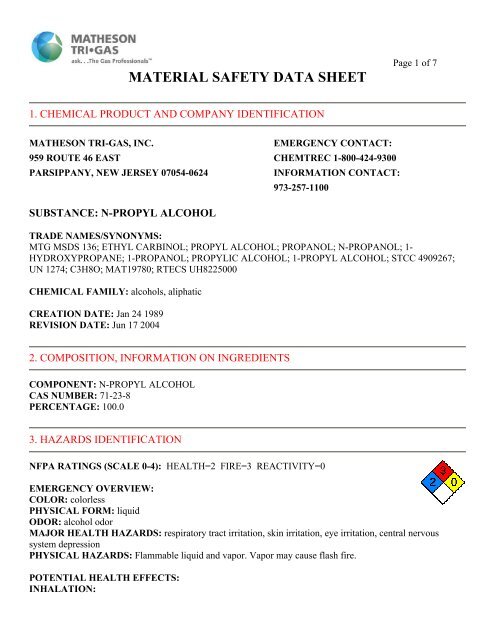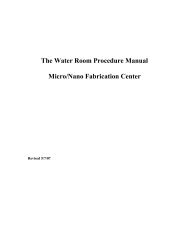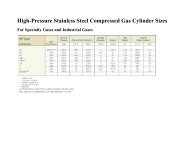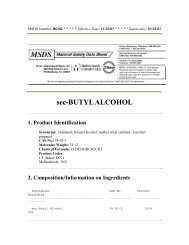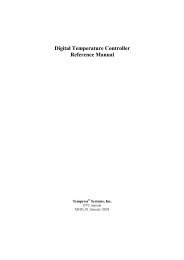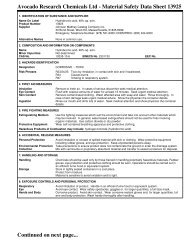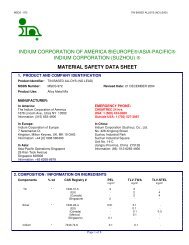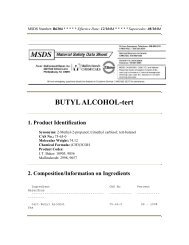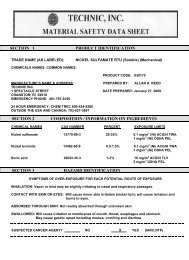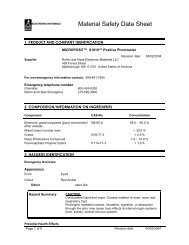MATERIAL SAFETY DATA SHEET
MATERIAL SAFETY DATA SHEET
MATERIAL SAFETY DATA SHEET
You also want an ePaper? Increase the reach of your titles
YUMPU automatically turns print PDFs into web optimized ePapers that Google loves.
<strong>MATERIAL</strong> <strong>SAFETY</strong> <strong>DATA</strong> <strong>SHEET</strong><br />
1. CHEMICAL PRODUCT AND COMPANY IDENTIFICATION<br />
MATHESON TRI-GAS, INC. EMERGENCY CONTACT:<br />
959 ROUTE 46 EAST CHEMTREC 1-800-424-9300<br />
PARSIPPANY, NEW JERSEY 07054-0624 INFORMATION CONTACT:<br />
SUBSTANCE: N-PROPYL ALCOHOL<br />
973-257-1100<br />
Page 1 of 7<br />
TRADE NAMES/SYNONYMS:<br />
MTG MSDS 136; ETHYL CARBINOL; PROPYL ALCOHOL; PROPANOL; N-PROPANOL; 1-<br />
HYDROXYPROPANE; 1-PROPANOL; PROPYLIC ALCOHOL; 1-PROPYL ALCOHOL; STCC 4909267;<br />
UN 1274; C3H8O; MAT19780; RTECS UH8225000<br />
CHEMICAL FAMILY: alcohols, aliphatic<br />
CREATION DATE: Jan 24 1989<br />
REVISION DATE: Jun 17 2004<br />
2. COMPOSITION, INFORMATION ON INGREDIENTS<br />
COMPONENT: N-PROPYL ALCOHOL<br />
CAS NUMBER: 71-23-8<br />
PERCENTAGE: 100.0<br />
3. HAZARDS IDENTIFICATION<br />
NFPA RATINGS (SCALE 0-4): HEALTH=2 FIRE=3 REACTIVITY=0<br />
EMERGENCY OVERVIEW:<br />
COLOR: colorless<br />
PHYSICAL FORM: liquid<br />
ODOR: alcohol odor<br />
MAJOR HEALTH HAZARDS: respiratory tract irritation, skin irritation, eye irritation, central nervous<br />
system depression<br />
PHYSICAL HAZARDS: Flammable liquid and vapor. Vapor may cause flash fire.<br />
POTENTIAL HEALTH EFFECTS:<br />
INHALATION:
Page 2 of 7<br />
SHORT TERM EXPOSURE: irritation, nausea, difficulty breathing, headache, drowsiness, dizziness, loss of<br />
coordination, liver damage, unconsciousness<br />
LONG TERM EXPOSURE: no information on significant adverse effects<br />
SKIN CONTACT:<br />
SHORT TERM EXPOSURE: irritation<br />
LONG TERM EXPOSURE: irritation<br />
EYE CONTACT:<br />
SHORT TERM EXPOSURE: irritation<br />
LONG TERM EXPOSURE: irritation<br />
INGESTION:<br />
SHORT TERM EXPOSURE: same as effects reported in short term inhalation, changes in blood pressure,<br />
diarrhea, stomach pain<br />
LONG TERM EXPOSURE: no information on significant adverse effects<br />
4. FIRST AID MEASURES<br />
INHALATION: If adverse effects occur, remove to uncontaminated area. Give artificial respiration if not<br />
breathing. Get immediate medical attention.<br />
SKIN CONTACT: Wash skin with soap and water for at least 15 minutes while removing contaminated<br />
clothing and shoes. Get medical attention, if needed. Thoroughly clean and dry contaminated clothing and shoes<br />
before reuse.<br />
EYE CONTACT: Flush eyes with plenty of water for at least 15 minutes. Then get immediate medical<br />
attention.<br />
INGESTION: Never make an unconscious person vomit or drink fluids. When vomiting occurs, keep head<br />
lower than hips to help prevent aspiration. If person is unconscious, turn head to side. Get medical attention<br />
immediately.<br />
NOTE TO PHYSICIAN: For ingestion, consider activated charcoal slurry. For ingestion, consider gastric<br />
lavage.<br />
5. FIRE FIGHTING MEASURES<br />
FIRE AND EXPLOSION HAZARDS: Severe fire hazard. The vapor is heavier than air. Vapors or gases may<br />
ignite at distant ignition sources and flash back. Vapor/air mixtures are explosive above flash point.<br />
EXTINGUISHING MEDIA: alcohol resistant foam, carbon dioxide, regular dry chemical, water, alcohol<br />
resistant foam<br />
Large fires: Use alcohol-resistant foam or flood with fine water spray.<br />
FIRE FIGHTING: Move container from fire area if it can be done without risk. Cool containers with water
Page 3 of 7<br />
spray until well after the fire is out. Stay away from the ends of tanks. For fires in cargo or storage area: Cool<br />
containers with water from unmanned hose holder or monitor nozzles until well after fire is out. If this is<br />
impossible then take the following precautions: Keep unnecessary people away, isolate hazard area and deny<br />
entry. Let the fire burn. Withdraw immediately in case of rising sound from venting safety device or any<br />
discoloration of tanks due to fire. For tank, rail car or tank truck: Evacuation radius: 800 meters (1/2 mile). Do<br />
not attempt to extinguish fire unless flow of material can be stopped first. Flood with fine water spray. Do not<br />
scatter spilled material with high-pressure water streams. Cool containers with water spray until well after the<br />
fire is out. Apply water from a protected location or from a safe distance. Avoid inhalation of material or<br />
combustion by-products. Stay upwind and keep out of low areas. Water may be ineffective.<br />
FLASH POINT: 73 F (23 C) (CC)<br />
LOWER FLAMMABLE LIMIT: 2.2%<br />
UPPER FLAMMABLE LIMIT: 13.7%<br />
AUTOIGNITION: 774 F (412 C)<br />
FLAMMABILITY CLASS (OSHA): IC<br />
6. ACCIDENTAL RELEASE MEASURES<br />
OCCUPATIONAL RELEASE:<br />
Avoid heat, flames, sparks and other sources of ignition. Remove sources of ignition. Stop leak if possible<br />
without personal risk. Reduce vapors with water spray. Small spills: Absorb with sand or other non-combustible<br />
material. Collect spilled material in appropriate container for disposal. Large spills: Dike for later disposal.<br />
Keep unnecessary people away, isolate hazard area and deny entry. Stay upwind and keep out of low areas.<br />
7. HANDLING AND STORAGE<br />
STORAGE: Store and handle in accordance with all current regulations and standards. Subject to storage<br />
regulations: U.S. OSHA 29 CFR 1910.106. Grounding and bonding required. Keep separated from<br />
incompatible substances.<br />
8. EXPOSURE CONTROLS, PERSONAL PROTECTION<br />
EXPOSURE LIMITS:<br />
N-PROPYL ALCOHOL:<br />
200 ppm (500 mg/m3) OSHA TWA<br />
250 ppm (614 mg/m3) OSHA STEL (vacated by 58 FR 35338, June 30, 1993)<br />
200 ppm ACGIH TWA<br />
400 ppm ACGIH STEL<br />
200 ppm (500 mg/m3) NIOSH recommended TWA 10 hour(s) (skin)<br />
250 ppm (625 mg/m3) NIOSH recommended STEL (skin)<br />
VENTILATION: Provide local exhaust ventilation system. Ventilation equipment should be explosionresistant<br />
if explosive concentrations of material are present. Ensure compliance with applicable exposure limits.
Page 4 of 7<br />
EYE PROTECTION: Wear splash resistant safety goggles with a faceshield. Provide an emergency eye wash<br />
fountain and quick drench shower in the immediate work area.<br />
CLOTHING: Wear appropriate chemical resistant clothing.<br />
GLOVES: Wear appropriate chemical resistant gloves.<br />
RESPIRATOR: The following respirators and maximum use concentrations are drawn from NIOSH and/or<br />
OSHA.<br />
800 ppm<br />
Any chemical cartridge respirator with organic vapor cartridge(s).<br />
Any powered, air-purifying respirator with organic vapor cartridge(s).<br />
Any air-purifying respirator with a full facepiece and an organic vapor canister.<br />
Any supplied-air respirator.<br />
Any self-contained breathing apparatus with a full facepiece.<br />
Escape -<br />
Any air-purifying respirator with a full facepiece and an organic vapor canister.<br />
Any appropriate escape-type, self-contained breathing apparatus.<br />
For Unknown Concentrations or Immediately Dangerous to Life or Health -<br />
Any supplied-air respirator with full facepiece and operated in a pressure-demand or other positive-pressure<br />
mode in combination with a separate escape supply.<br />
Any self-contained breathing apparatus with a full facepiece.<br />
9. PHYSICAL AND CHEMICAL PROPERTIES<br />
PHYSICAL STATE: liquid<br />
COLOR: colorless<br />
ODOR: alcohol odor<br />
MOLECULAR WEIGHT: 60.10<br />
MOLECULAR FORMULA: C-H3-C-H2-C-H2-O-H<br />
BOILING POINT: 207 F (97 C)<br />
FREEZING POINT: -197 F (-127 C)<br />
VAPOR PRESSURE: 14 mmHg @ 20 C<br />
VAPOR DENSITY (air=1): 2.1<br />
SPECIFIC GRAVITY (water=1): 0.8053<br />
WATER SOLUBILITY: soluble<br />
PH: Not available<br />
VOLATILITY: Not available<br />
ODOR THRESHOLD: 30 ppm<br />
EVAPORATION RATE: Not available<br />
VISCOSITY: 2.256 cP @ 20 C<br />
COEFFICIENT OF WATER/OIL DISTRIBUTION: Not available<br />
SOLVENT SOLUBILITY:<br />
Soluble: alcohol, ether, acetone, benzene
10. STABILITY AND REACTIVITY<br />
REACTIVITY: Stable at normal temperatures and pressure.<br />
Page 5 of 7<br />
CONDITIONS TO AVOID: Avoid heat, flames, sparks and other sources of ignition. Containers may rupture<br />
or explode if exposed to heat.<br />
INCOMPATIBILITIES: metals, oxidizing materials, combustible materials, bases, metal salts<br />
HAZARDOUS DECOMPOSITION:<br />
Thermal decomposition products: oxides of carbon<br />
POLYMERIZATION: Will not polymerize.<br />
11. TOXICOLOGICAL INFORMATION<br />
N-PROPYL ALCOHOL:<br />
IRRITATION <strong>DATA</strong>:<br />
500 mg open skin-rabbit mild; 20 mg/24 hour(s) eyes-rabbit moderate; 100 percent/47 hour(s) skin-human mild;<br />
100 percent/24 hour(s) skin-human mild<br />
TOXICITY <strong>DATA</strong>:<br />
48 gm/m3 inhalation-mouse LC50; 5040 mg/kg skin-rabbit LD50; 1870 mg/kg oral-rat LD50<br />
CARCINOGEN STATUS: ACGIH: A3 -Animal Carcinogen<br />
LOCAL EFFECTS:<br />
Irritant: inhalation, skin, eye<br />
ACUTE TOXICITY LEVEL:<br />
Moderately Toxic: inhalation, ingestion<br />
Slightly Toxic: dermal absorption<br />
TARGET ORGANS: central nervous system<br />
MEDICAL CONDITIONS AGGRAVATED BY EXPOSURE: kidney disorders, respiratory disorders, skin<br />
disorders and allergies<br />
TUMORIGENIC <strong>DATA</strong>: Available.<br />
MUTAGENIC <strong>DATA</strong>: Available.<br />
REPRODUCTIVE EFFECTS <strong>DATA</strong>: Available.<br />
ADDITIONAL <strong>DATA</strong>: Alcohol may enhance the toxic effects.<br />
12. ECOLOGICAL INFORMATION<br />
ECOTOXICITY <strong>DATA</strong>:<br />
FISH TOXICITY: 3000000-4000000 ug/L 96 hour(s) LC50 (Mortality) Bleak (Alburnus alburnus)<br />
INVERTEBRATE TOXICITY: 3644000 ug/L 48 hour(s) EC50 (Immobilization) Water flea (Daphnia<br />
magna)
Page 6 of 7<br />
ALGAL TOXICITY: 2900000 ug/L 48 hour(s) (Population Growth) Green algae (Scenedesmus pannonicus)<br />
OTHER TOXICITY: 4000000 ug/L 48 week(s) LC50 (Mortality) Mexican axolotl (Ambystoma mexicanum)<br />
ENVIRONMENTAL SUMMARY: Relatively non-toxic to aquatic life.<br />
13. DISPOSAL CONSIDERATIONS<br />
Subject to disposal regulations: U.S. EPA 40 CFR 262. Hazardous Waste Number(s): D001. Dispose in<br />
accordance with all applicable regulations.<br />
14. TRANSPORT INFORMATION<br />
U.S. DOT 49 CFR 172.101:<br />
PROPER SHIPPING NAME: n-Propanol<br />
ID NUMBER: UN1274<br />
HAZARD CLASS OR DIVISION: 3<br />
PACKING GROUP: II<br />
LABELING REQUIREMENTS: 3<br />
CANADIAN TRANSPORTATION OF DANGEROUS GOODS:<br />
SHIPPING NAME: n-Propanol<br />
UN NUMBER: UN1274<br />
CLASS: 3<br />
PACKING GROUP/RISK GROUP: II<br />
15. REGULATORY INFORMATION<br />
U.S. REGULATIONS:<br />
CERCLA SECTIONS 102a/103 HAZARDOUS SUBSTANCES (40 CFR 302.4): Not regulated.<br />
SARA TITLE III SECTION 302 EXTREMELY HAZARDOUS SUBSTANCES (40 CFR 355.30): Not<br />
regulated.<br />
SARA TITLE III SECTION 304 EXTREMELY HAZARDOUS SUBSTANCES (40 CFR 355.40): Not<br />
regulated.<br />
SARA TITLE III SARA SECTIONS 311/312 HAZARDOUS CATEGORIES (40 CFR 370.21):<br />
ACUTE: Yes<br />
CHRONIC: No<br />
FIRE: Yes<br />
REACTIVE: No
SUDDEN RELEASE: No<br />
SARA TITLE III SECTION 313 (40 CFR 372.65): Not regulated.<br />
OSHA PROCESS <strong>SAFETY</strong> (29CFR1910.119): Not regulated.<br />
STATE REGULATIONS:<br />
California Proposition 65: Not regulated.<br />
CANADIAN REGULATIONS:<br />
WHMIS CLASSIFICATION: Not determined.<br />
NATIONAL INVENTORY STATUS:<br />
U.S. INVENTORY (TSCA): Listed on inventory.<br />
TSCA 12(b) EXPORT NOTIFICATION: Not listed.<br />
CANADA INVENTORY (DSL/NDSL): Not determined.<br />
16. OTHER INFORMATION<br />
©Copyright 1984-2005 MDL Information Systems, Inc. All rights reserved.<br />
Page 7 of 7<br />
MATHESON TRI-GAS, INC. MAKES NO EXPRESS OR IMPLIED WARRANTIES, GUARANTEES<br />
OR REPRESENTATIONS REGARDING THE PRODUCT OR THE INFORMATION HEREIN,<br />
INCLUDING BUT NOT LIMITED TO ANY IMPLIED WARRANTY OF MERCHANTABILITY OR<br />
FITNESS FOR USE. MATHESON TRI-GAS, INC. SHALL NOT BE LIABLE FOR ANY PERSONAL<br />
INJURY, PROPERTY OR OTHER DAMAGES OF ANY NATURE, WHETHER COMPENSATORY,<br />
CONSEQUENTIAL, EXEMPLARY, OR OTHERWISE, RESULTING FROM ANY PUBLICATION,<br />
USE OR RELIANCE UPON THE INFORMATION HEREIN.


